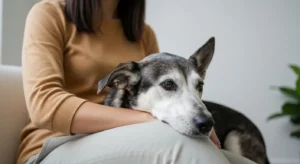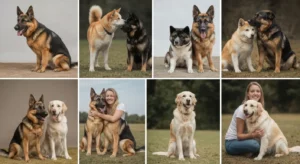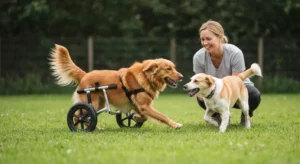As a Certified Veterinary Technician with over 15 years of experience in both emergency clinics and general practice, I’ve seen firsthand the difference that thoughtful preparation can make when traveling with pets. While a spur-of-the-moment road trip sounds romantic, for our animal companions, it can be a source of immense stress and anxiety. The new sights, sounds, and smells, combined with the unfamiliar motion of a car or plane, can be overwhelming.
The good news is that with the right approach, you can transform travel from a stressful ordeal into a wonderful bonding experience for you and your pet. It all comes down to planning, patience, and understanding the world from their perspective. My goal with these pet travel tips is to empower you with the expert knowledge and practical steps needed to ensure every journey is safe, comfortable, and fun for your four-legged family member. Let’s get you and your pet ready for your next adventure.
-
Tip #1: Acclimatize Your Pet to Travel Well Before Your Trip
The Point: The biggest mistake I see owners make is assuming their pet will be fine in a carrier or a car just because they have to be. The first time your pet experiences their travel crate or a long car ride should never be on the day of your 8-hour drive. Gradual and positive acclimatization is the single most important step for preventing travel-related fear and anxiety.
The ‘Why’: Animals, especially cats and many dogs, are creatures of habit and territory. A moving vehicle and a small, enclosed carrier are alien environments. Forcing them into this situation without preparation triggers their fight-or-flight response. This creates a powerful negative association, meaning the next time they see the carrier or the car, their anxiety will start long before the journey does. This can manifest as excessive vocalization, panting, drooling, or even aggression. Positive, slow exposure, a process called desensitization and counter-conditioning, rewires their brain to see the carrier and car as safe, or even rewarding, places.
The Actionable Advice:
1. Make the Carrier a Sanctuary:- Start weeks or even months before your trip. Place the travel carrier in a main living area with the door permanently open.
- Make it inviting. Put their favorite soft blanket, a worn t-shirt with your scent, and high-value treats or toys inside.
- Start feeding your pet their meals near the carrier, then eventually, inside the carrier. This builds a strong positive association. Never force them inside.
- Once they willingly go in to eat or rest, you can start closing the door for a few seconds, then opening it and giving a treat. Gradually increase the duration the door is closed while you remain in the room.
2. Get Them Used to the Car:
- Once your pet is comfortable in their carrier, start taking them out to the car. Don’t start the engine. Just place the carrier securely in the back seat, sit with them for a few minutes, and give them treats and praise. Then go back inside. Repeat this for several days.
- Next, turn the engine on for a minute or two, then turn it off. Reward and go back inside.
- Finally, start with extremely short trips. A drive around the block, followed by an immediate return home and a big reward (like a favorite chew toy or a play session). Gradually lengthen the drives to a fun destination, like a park or a pet-friendly store, so they learn the car doesn’t always lead to the vet.
-
Tip #2: Build a Comprehensive Pet Travel Kit
The Point: Packing for your pet should be as thorough as packing for a child. Simply grabbing a bag of kibble and a leash is not enough. A well-stocked, dedicated travel kit ensures you are prepared for any situation, from a simple mealtime to a minor medical issue, reducing your stress and keeping your pet safe and comfortable.
The ‘Why’: Being in an unfamiliar place means you won’t have your usual resources at your fingertips. The local store at your destination may not carry your pet’s specific food, which can lead to gastrointestinal upset. If your pet has a minor injury or anxiety flair-up, having supplies on hand can prevent a frantic search for an emergency vet. A proper kit provides consistency and safety, which are the cornerstones of a low-stress trip for your pet.
The Actionable Advice:
Use this checklist to create a dedicated travel bag for your pet:- Food and Water: Pack more food than you think you’ll need in case of delays. Bring bottled water from home or purchase gallons of purified water to avoid stomach upset from different tap water. Don’t forget collapsible food and water bowls.
- Medications and Records: Pack any prescription medications your pet takes daily, along with a few extra doses. Crucially, bring a printed or digital copy of their vaccination records and your veterinarian’s contact information. If crossing state lines, a recent Certificate of Veterinary Inspection (CVI) may be required—check your destination’s regulations.
- First-Aid Kit: This is non-negotiable. Your kit should include:
- Gauze pads and adhesive tape
- Antiseptic wipes (povidone-iodine or chlorhexidine)
- Saline eye wash
- Styptic powder to stop minor bleeding (like from a broken nail)
- Blunt-nosed scissors and tweezers
- An instant cold pack
- Contact information for the ASPCA Animal Poison Control Center: (888) 426-4435
- Any vet-approved antihistamine (like Benadryl) for allergic reactions—always ask your vet for the correct dosage for your specific pet before you leave.
- Comfort and Sanity Items: Pack their favorite bed or blanket, a few durable toys (a puzzle toy can be great for hotel downtime), and long-lasting chews. The familiar scent will help them settle in a new place.
- Cleaning Supplies: Pack poop bags, paper towels, and an enzyme-based cleaner (like Nature’s Miracle) for inevitable accidents.
-
Tip #3: Proactively Manage Motion Sickness and Anxiety
The Point: Don’t wait for your pet to start drooling, panting, or whining to address their discomfort. Proactively managing both the physical feelings of motion sickness and the emotional stress of travel is key to a pleasant journey for everyone involved.
The ‘Why’: Motion sickness is a real physiological response in pets, caused by the disconnect between what their eyes see and what their inner ear’s vestibular system feels. This sensory conflict leads to nausea, drooling, and vomiting. Anxiety exacerbates this and can also present with similar signs, like panting and restlessness. If a pet experiences these symptoms on a trip, they will quickly learn to dread car travel, making future trips even more challenging. Addressing it from both a behavioral and, when necessary, a medical standpoint is the most effective strategy.
The Actionable Advice:
1. Consult Your Veterinarian: This should always be your first step. Your vet is your best resource for travel health. They can help you determine if your pet’s signs are due to anxiety, nausea, or both, and recommend the safest solutions. Never give your pet any human medication without explicit veterinary guidance, as dosages and side effects can be very different.
2. Withhold Food Before Departure: To reduce the likelihood of nausea and vomiting, it’s best to withhold food for 4-6 hours before you get in the car. Small sips of water are generally fine.
3. Use Calming Aids:- Pheromone Products: Sprays and diffusers like Adaptil (for dogs) and Feliway (for cats) mimic natural calming pheromones. Spray your pet’s carrier and bedding 15-20 minutes before they get in.
- Thundershirts or Anxiety Wraps: These products apply gentle, constant pressure, which has a calming effect on many animals, similar to swaddling an infant.
4. Discuss Medication with Your Vet: If behavioral modification isn’t enough, medication can be a game-changer. Your vet might recommend:
- Anti-Nausea Medication: Cerenia (maropitant citrate) is a highly effective and safe prescription medication for preventing vomiting due to motion sickness in both dogs and cats.
- Anti-Anxiety Medication: For moderate to severe travel anxiety, your vet might prescribe medications like Trazodone or Gabapentin. These can help your pet relax without heavy sedation. It’s often recommended to do a “trial run” with the medication at home before the trip to see how your pet reacts.
-
Tip #4: Plan Your Route and Stays with Your Pet in Mind
The Point: A successful pet-friendly trip requires more than just finding a hotel that allows animals. You need to plan your entire itinerary—from rest stops to nightly accommodations—through the lens of your pet’s needs and safety.
The ‘Why’: Spontaneity is the enemy of safe pet travel. Without a pet-centric plan, you risk finding yourself in a town with no pet-friendly lodging, forcing you to make unsafe choices like leaving your pet in the car. You might also find that a “pet-friendly” hotel has restrictive weight limits, breed restrictions, or exorbitant fees you weren’t prepared for. Planning ahead eliminates these stressful surprises and ensures your pet is a welcome guest, not an inconvenient afterthought.
The Actionable Advice:
1. Book Accommodations in Advance and Verify Policies:- Use websites that specifically filter for pet-friendly hotels, but always call the hotel directly to confirm their policy before booking.
- Ask specific questions: “Do you have a weight limit?” “Are there any breed restrictions?” “What is the pet fee?” “Are pets allowed to be left unattended in the room?” (Many hotels do not allow this.) “Is there a designated pet relief area?”
2. Map Out Your Rest Stops:
- Plan to stop every 2-3 hours. This allows your pet to stretch their legs, go to the bathroom, and have a drink of water.
- Use apps like Google Maps to look for rest areas with green space, away from the busiest parts of the parking lot.
- Always keep your pet on a secure, well-fitted leash and harness during stops. A frightened pet can easily slip a collar and bolt into traffic. Never open the car door until their leash is securely attached.
3. Research Your Destination:
- Before you go, look up local pet-friendly restaurants (with patios), parks, and hiking trails.
- Crucially, identify the nearest 24-hour emergency veterinary hospital to your hotel and save their number and address in your phone. You hope you’ll never need it, but if you do, you’ll be glad you’re not scrambling to find one in a panic.
-
Tip #5: Prioritize In-Transit Safety Above All Else
The Point: A loose, unrestrained pet in a moving vehicle is a significant safety hazard. Proper restraint is not about convenience; it is a critical measure to protect your pet, you, and other drivers on the road.
The ‘Why’: The laws of physics are unforgiving. In an accident or even a sudden stop, an unrestrained 30-pound dog can become a projectile with hundreds of pounds of force, causing serious injury to themselves and human passengers. Beyond a crash, a loose pet is a major distraction for the driver. They can climb into the driver’s lap, get stuck under the brake pedal, or jump out of an open window. Furthermore, if you are in an accident, a panicked and unrestrained pet is very likely to escape the vehicle and run into traffic.
The Actionable Advice:
Choose a safety-tested restraint method and use it every single time.
1. Use a Crash-Tested Crate or Carrier:- This is widely considered the safest way for a pet to travel. A sturdy, well-ventilated crate, secured in the vehicle (e.g., with straps or in the cargo area of an SUV), contains your pet and absorbs impact forces.
- Look for crates that have been independently tested and certified by the Center for Pet Safety (CPS).
- Position the crate in the back seat or cargo area—never in the front seat, where a deploying airbag could be fatal to a pet.
2. Use a Crash-Tested Safety Harness:
- If a crate is not feasible, a high-quality, crash-tested harness that attaches to the car’s seatbelt system is the next best option.
- Do not confuse a walking harness with a car safety harness. A proper safety harness is made of durable material with strong metal hardware and has been specifically engineered and tested for crash protection. Again, look for CPS certification.
- These harnesses keep your pet in their seat, preventing distraction and injury.
3. Follow These Unbreakable Rules:
- NEVER let your pet ride with their head out the window. It may look fun, but it exposes them to eye injuries from road debris, insects, or wind, and carries the risk of them falling or jumping out.
- NEVER leave your pet unattended in a vehicle. On a 70°F day, the temperature inside a car can rocket to over 100°F in just 20 minutes, causing heatstroke and death. Cracking a window does very little to slow this process. It is never worth the risk.
-
Tip #6: Maintain Routine and Familiarity on the Road
The Point: While you’re enjoying a break from your normal routine, your pet is craving it. Maintaining as much of their home schedule as possible is a powerful tool for reducing stress and helping them feel secure in an unfamiliar environment.
The ‘Why’: Animals thrive on predictability. Their daily rituals—what time they eat, when they go for a walk, when they settle down for the night—form the structure of their world. When that structure is removed during travel, it creates uncertainty and anxiety. By providing a familiar routine, you are giving them a predictable anchor in a sea of new and potentially stressful experiences. This tells them that even though the place is different, the core of their world is safe and stable.
The Actionable Advice:
1. Stick to Feeding Schedules: If you feed your dog at 7 AM and 6 PM at home, do your absolute best to feed them at 7 AM and 6 PM in the hotel room. This simple act of consistency is incredibly reassuring. Use the same food and the same bowls you brought from home.
2. Replicate Exercise and Potty Routines: Try to take them for walks around the same time you would at home. A good walk in the morning before you hit the road again and a relaxing one in the evening can help burn off nervous energy and signal that the day is winding down.
3. Create a Familiar “Home Base”: When you get to your hotel room or rental, immediately set up your pet’s “zone.” Lay down their bed or blanket from home, put out their water bowl, and give them a familiar toy. This creates a safe spot that smells like home, where they can retreat and relax.
4. Don’t Skip Bedtime Rituals: If you always give your pet a dental chew and a final potty break before bed, continue to do so on your trip. These small, repeated actions signal safety and predictability, helping your pet settle down for the night instead of pacing anxiously in a strange room.
Traveling with your pet doesn’t have to be a source of worry. By embracing these expert tips—focusing on careful preparation, safety, and your pet’s emotional well-being—you can create lasting, positive memories together. A little extra effort beforehand pays huge dividends in a happy, relaxed travel companion. Safe travels!












